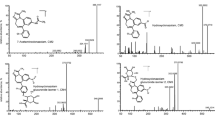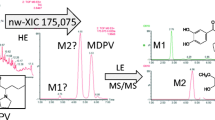Abstract
Municipal wastewater has been examined for steroids, β2-agonists, stimulants, diuretics, and phosphodiesterase type V inhibitors (PDE type V inhibitors), which are “dual-use-drugs” applied either as anabolic, doping, and lifestyle drugs or for treatment of diverse diseases. To identify their origin, fitness centre discharges under suspicion of being point sources and sewage-treatment plant feed and effluents were sampled and concentrations determined. Sensitive and selective methods for determination and quantification based on solid-phase extraction (SPE) followed by high-performance liquid chromatography–high resolution mass and tandem mass spectrometry (HPLC–(HR)MS and HPLC–MS–MS) were developed and established for analysis of these compounds in wastewater and to assess their effect on the environment. The methods developed enabled quantification at trace concentrations (limit of quantification (LOQ): 5 ng L−1). Of the steroids and stimulants under investigation, testosterone, methyltestosterone, and boldenone or ephedrine, amphetamine, and MDMA (3,4-methylendioxy-N-methylamphetamine) were observed at up to 5 μg L−1 (ephedrine). Of the β2-agonists salbutamol only, and of the diuretics furosemide and hydrochlorothiazide were confirmed in the extracts. Quite high concentrations of the PDE type V inhibitors sildenafil, tadalafil, and vardenafil and their metabolites were confirmed in fitness centre discharges (sildenafil: 1,945 ng L−1) whereas their concentrations in municipal wastewater did not exceed 35 ng L−1. This study identified anabolic and doping drugs in wastewater for the first time. Results obtained from wastewater treatment plant effluents proved that these “dual-use-drugs”, with the exception of hydrochlorothiazide, were mostly eliminated.

Anabolic, doping and lifestyle drugs on their ways into the environment







Similar content being viewed by others
References
Ternes TA (1998) Occurrence of drugs in German sewage treatment plants and rivers. Water Res 32:3245–3260
Körner W, Bolz U, Süßmuth W, Hiller G, Schuller W, Hanf V, Hagenmaier H (2000) Input/output balance of estrogenic active compounds in a major municipal sewage plant in Germany. Chemosphere 40:1131–1142
Ternes TA (2001) Analytical methods for the determination of pharmaceuticals in aqueous environmental samples. Trends Anal Chem 20:419–434
Kolpin DW, Furlong ET, Meyer MT, Thurman EM, Zaugg SD, Barber LB, Buxton HT (2002) Pharmaceuticals, hormones, and other organic wastewater contaminants in U.S. streams, 1999–2000: a national reconnaissance. Environ Sci Technol 36:1202–1211
Calamari D, Zuccato E, Castiglioni S, Bagnati R, Fanelli R (2003) Strategic survey of therapeutic drugs in the Rivers Po and Lambro in Northern Italy. Environ Sci Technol 37:1241–1248
Rodriguez-Mozaz S, Lopes de Alda MJ, Barceló D (2004) Picogram per liter level determination of estrogens in natural waters and waterworks by a fully automated on-line solid-phase extraction–liquid chromatography–electrospray tandem mass spectrometry method. Anal Chem 76:6998–7006
Zuccato E, Chiabrando C, Castiglioni S, Calamari D, Bagnati R, Schiarea S, Fanelli R (2005) Cocaine in surface waters: a new evidence-based tool to monitor community drug abuse. Environ Health 4:14. doi:10.1186/1476-069X-4-14
Castiglioni S, Zuccato E, Crisci E, Chiabrando Ch, Fanelli R, Bagnati R (2006) Identification and measurement of illicit drugs their metabolites in urban wastewater by liquid chromatography–tandem mass spectrometry. Anal Chem 78:8421–8429
Hummel D, Löffler D, Fink G, Ternes TA (2006) Simultaneous determination of psychoactive drugs and their metabolites in aqueous matrices by liquid chromatography mass spectrometry. Environ Sci Technol 40:7321–7328
Huerta-Fontela M, Galceran MT, Ventura F (2007) Ultraperformance liquid chromatography–tandem mass spectrometry analysis of stimulatory drugs of abuse in wastewater and surface waters. Anal Chem 79:3821–3829
Boleda R, Galceran T, Ventura F (2007) Trace determination of cannabinoids and opiates in wastewater and surface waters by ultra-performance liquid chromatography–tandem mass spectrometry. J Chromatogr A 1175:38–48
Bones J, Thomas KV, Paull B (2007) Using environmental analytical data to estimate levels of community consumption of illicit drugs and abused pharmaceuticals. J Environ Monit 9:701–707
Nieto A, Peschka M, Borrull F, Pocurull E, Marcé RM, Knepper TP (2009) Phosphodiesterase type V inhibitors: occurrence and fate in wastewater and sewage sludge. Water Res 44:1607–1615
Gebhardt W, Thevis M, Schröder HFr (2008) Occurrence and follow-up of anabolic and doping drugs during wastewater treatment by means of high resolution liquid chromatography–mass spectrometry (LC–MS and –MSn). Oral presentation during “25th Montreux Symposium on LC–MS–MS”; 12.–14.11.2008 in Montreux (Switzerland), Proceedings p 17
Hemmersbach P, de la Torre R (1996) Stimulants, narcotics and β-blockers: 25 years of development in analytical techniques for doping control. J Chromatogr B 687:221–238
Holt RIG, Erotokritou-Mulligan I, Sonksen PH (2009) The history of doping and growth hormone abuse in sport. Growth Horm IGF Res 19:320–326
Hemmersbach P (2008) History of mass spectrometry at the Olympic Games. J Mass Spectrom 43:839–853
Guermouche MH, Bensalah K (2006) Solid phase extraction and liquid chromatographic determination of sildenafil and N-demethylsidenafil in rat serum with basic mobile phase. J Pharmceut Biomed 40:952–957
Thevis M, Schänzer W (2005) Examples of doping control analysis by liquid chromatography–tandem mass spectrometry: ephedrines, beta-receptor blocking agents, diuretics, sympathomimetics, and cross-linked hemoglobins. J Chromatogr Sci 43:22–31
Gergov M, Ojanperä I, Vuori E (2003) Simultaneous screening for 238 drugs in blood by liquid chromatography–ionspray tandem mass spectrometry with multiple-reaction monitoring. J Chromatogr B 795:41–53
Weinmann W, Goerner M, Vogt S, Goerke R, Pollak S (2001) Fast confirmation of 11-nor-9-carboxy-Delta(9)-tetrahydrocannabinol (THC-COOH) in urine by LC–MS–MS using negative atmospheric-pressure chemical ionisation (APCI). Forensic Sci Int 121:103–107
Concheiro M, de Castro A, Quintela O, Cruz A, Lopez-Rivadulla M (2004) Development and validation of a method for the quantitation of Δ9tetrahydrocannabinol in oral fluid by liquid chromatography electrospray–mass-spectrometry. J Chromatogr B 810:319–324
Teixeira H, Proença P, Verstraete A, Corte-Real F, Vieira DN (2005) Analysis of Delta(9)-tetrahydrocannabinol in oral fluid samples using solid-phase extraction and high-performance liquid chromatography–electrospray ionization mass spectrometry. Forensic Sci Int 150:205–211
Laloup M, del Mar Ramirez FM, Wood M, De Boeck G, Henquet C, Maes V, Samyn N (2005) Quantitative analysis of Δ9-tetrahydrocannabinol in preserved oral fluid by liquid chromatography–tandem mass spectrometry. J Chromatogr A 1082:15–24
Maralikova B, Weinmann W (2004) Simultaneous determination of Delta(9)-tetrahydrocannabinol, 11-hydroxy-Delta(9)-tetrahydrocannabinol and 11-nor-9-carboxy-Delta(9)-tetrahydrocannabinol in human plasma by high-performance liquid chromatography/tandem mass spectrometry. J Mass Spectrom 39:526–531
Maralikova B, Weinmann W (2004) Confirmatory analysis for drugs of abuse in plasma and urine by high-performance liquid chromatography–tandem mass spectrometry with respect to criteria for compound identification. J Chromatogr B 811:21–30
Choo RE, Murphy CM, Jones HE, Huestis MA (2005) (2005) Determination of methadone, 2-ethylidene-1, 5-dimethyl-3, 3-diphenylpyrrolidine, 2-ethyl-5-methyl-3, 3-diphenylpyraline and methadol in meconium by liquid chromatography atmospheric pressure chemical ionization tandem mass spectrometry. J Chromatogr B 814:369–373
Wood M, Laloup M, del Mar Ramirez FM, Jenkins KM, Young MS, Ramaekers JG, De Boeck G, Samun N (2005) Quantitative analysis of multiple illicit drugs in preserved oral fluid by solid-phase extraction and liquid chromatography–tandem mass spectrometry. Forensic Sci Int 150:227–238
Wood M, Laloup M, Samyn N, del Mar Ramirez FM, de Bruijin EA, Maes RAA, De Boeck G (2006) Recent applications of liquid chromatography–mass spectrometry in forensic science. J Chromatogr A 1130:3–15
European Union Decision 2002/657/EC (2002) Commission decision of 12 August 2002 implementing Council Directive 96/23/EC concerning the performance of analytical methods and the interpretation of results. Off J Eur Commun 221(482):8–38
Rivier L (2003) Criteria for the identification of compounds by liquid chromatography–mass spectrometry and liquid chromatography–multiple mass spectrometry in forensic toxicology and doping analysis. Anal Chim Acta 492:69–82
Gebhardt W, Schröder HFr (2007) LC–MS and –MS–MS for the Follow-Up of the Elimination of Persistent Pharmaceuticals During Wastewater Treatment Applying Biological Wastewater Treatment and Advanced Oxidation. J Chromatogr A 1160:34–43
Hogenboom AC, van Leerdam JA, de Voogt P (2009) Accurate mass screening and identification of emerging contaminants in environmental samples by liquid chromatography–hybrid linear ion trap Orbitrap mass spectrometry. J Chromatogr A 1216:510–519
International Conference on Harmonisation of Technical Requirements for Registration of Pharmaceuticals for Human Use (2005) ICH harmonised tripartite guideline, validation of analytical procedures: methodology (Q2(R1). http://www.ich.org/LOB/media/MEDIA417.pdf, accessed 08.September 2008
Kromidas A (1999) Validierung in der Analytik. Wiley-VCH, Weinheim
Weinmann W, Bohnert M, Wiedemann A, Renz M, Lehmann N, Pollak S (2001) Post-mortem detection and identification of silenafil (viagra) and its metabolites by LC–MS and LC–MS–MS. Int J Leg Med 114:252–258
Kim J, Ji HY, Kim SJ, Lee HW, Lee SS, Kim DS, Yoo M, Kim WB, Lee HS (2003) Simultaneous determination of sildenafil and its active metabolite UK-103, 320 in human plasma using liquid chromatography–tandem mass spectrometry. J Pharm Biomed Anal 32:317–322
Ku HY, Shon JH, Liu KH, Shin JG, Bae SK (2009) Liquid chromatography/tandem mass spectrometry method for the simultaneous determination of vardenafil and its major metabolite, N-desethylvardenafil, in human plasma: application to a pharmacokinetic study. J Chromatogr B 877:95–100
Radjenovic J, Petrovic M, Barceló D (2007) Analysis of pharmaceuticals in wastewater and removal using a membrane bioreactor. Anal Bioanal Chem 387:1365–1377
Radjenovic J, Petrovic M, Barceló D (2009) Fate and distribution of pharmaceuticals in wastewater and sewage sludge of the conventional activated sludge (CAS) and advanced membrane bioreactor (MBR) treatment. Water Res 43:831–841
Acknowledgements
The authors thank the employees of the workshop of the Institute of Environmental Engineering for their fruitful support during wastewater sample collection.
Author information
Authors and Affiliations
Corresponding author
Electronic supplementary material
Below is the link to the electronic supplementary material.
ESM 1
(PDF 479 kb)
Rights and permissions
About this article
Cite this article
Fr. Schröder, H., Gebhardt, W. & Thevis, M. Anabolic, doping, and lifestyle drugs, and selected metabolites in wastewater—detection, quantification, and behaviour monitored by high-resolution MS and MSn before and after sewage treatment. Anal Bioanal Chem 398, 1207–1229 (2010). https://doi.org/10.1007/s00216-010-3958-3
Received:
Revised:
Accepted:
Published:
Issue Date:
DOI: https://doi.org/10.1007/s00216-010-3958-3




